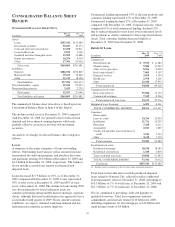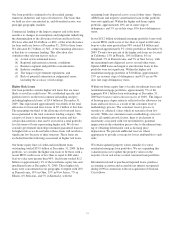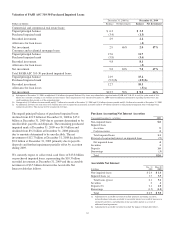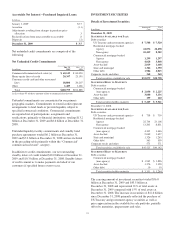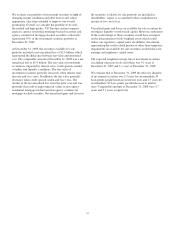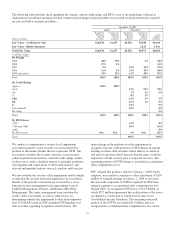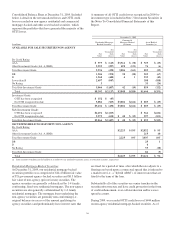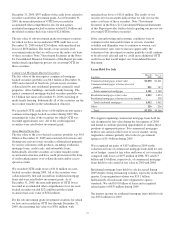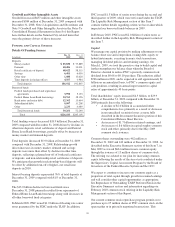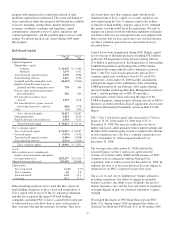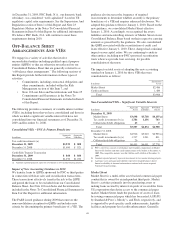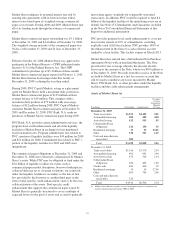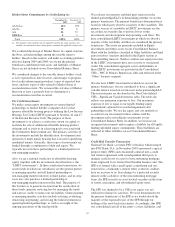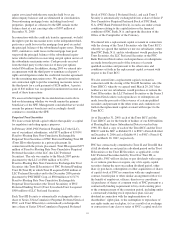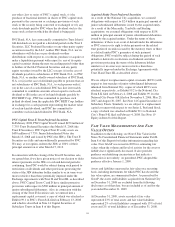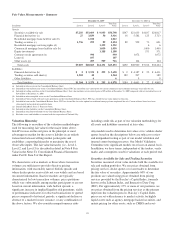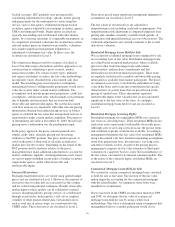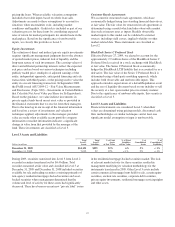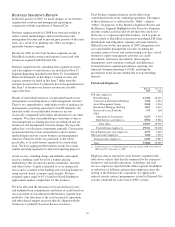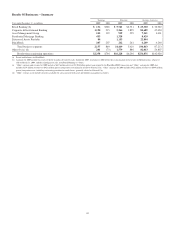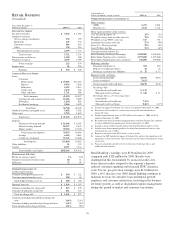PNC Bank 2009 Annual Report Download - page 44
Download and view the complete annual report
Please find page 44 of the 2009 PNC Bank annual report below. You can navigate through the pages in the report by either clicking on the pages listed below, or by using the keyword search tool below to find specific information within the annual report.
At December 31, 2009, PNC Bank, N.A., our domestic bank
subsidiary, was considered “well capitalized” based on US
regulatory capital ratio requirements. See the Supervision And
Regulation section of Item 1 of this Report and Note 23
Regulatory Matters in the Notes To Consolidated Financial
Statements in Item 8 of this Report for additional information.
We believe PNC Bank, N.A. will continue to meet these
requirements during 2010.
O
FF
-B
ALANCE
S
HEET
A
RRANGEMENTS
A
ND
VIE
S
We engage in a variety of activities that involve
unconsolidated entities including qualified special purpose
entities (QSPEs) or that are otherwise not reflected on our
Consolidated Balance Sheet that are generally referred to as
“off-balance sheet arrangements.” The following sections of
this Report provide further information on these types of
activities:
• Commitments, including contractual obligations and
other commitments, included within the Risk
Management section of this Item 7, and
• Note 10 Loan Sales and Securitizations and Note 25
Commitments and Guarantees in the Notes To
Consolidated Financial Statements included in Item 8
of this Report.
The following provides a summary of variable interest entities
(VIEs), including those that we have consolidated and those in
which we hold a significant variable interest but have not
consolidated into our financial statements as of December 31,
2009 and December 31, 2008.
Consolidated VIEs – PNC Is Primary Beneficiary
In millions
Aggregate
Assets
Aggregate
Liabilities
Tax credit investments (a)
December 31, 2009 $1,933 $ 808
December 31, 2008 $1,690 $ 921
Credit Risk Transfer Transaction
December 31, 2009 $ 860 $ 860
December 31, 2008 $1,070 $1,070
(a) Amounts reported primarily represent investments in low income housing projects.
Impact of New Accounting Guidance in 2010
We transfer loans to QSPEs sponsored by PNC or third parties
in connection with loan sales and securitization transactions.
These transactions effectively transfer the risk to the QSPE
and permit the loans to be excluded from our Consolidated
Balance Sheet. See Note 10 Loan Sales and Securitizations
included in the Notes To Consolidated Financial Statements in
Item 8 of this Report for additional information.
The FASB issued guidance during 2009 that removes the
nonconsolidation exception for QSPEs and includes new
criteria for determining the primary beneficiary of a VIE. The
guidance also increases the frequency of required
reassessments to determine whether an entity is the primary
beneficiary of a VIE and requires enhanced disclosures. We
adopted this guidance effective January 1, 2010. Based on the
new guidance, we consolidated Market Street effective
January 1, 2010. Accordingly, we recognized the assets,
liabilities and noncontrolling interests of Market Street on our
Consolidated Balance Sheet based on their respective carrying
amounts as prescribed by the guidance. We also consolidated
the QSPE associated with the securitization of credit card
loans effective January 1, 2010. These changes had a minimal
impact on our capital ratios. We are continuing to analyze
other entities, including non-PNC sponsored securitization
trusts where we provide loan servicing, for possible
consolidation of the trusts.
The impact on total assets of adopting this new accounting
standard on January 1, 2010 for those VIEs that were
consolidated is as follows:
In millions
Incremental
Assets
Market Street $2,486
Credit card loans 1,480
Total $3,966
Non-Consolidated VIEs – Significant Variable Interests
In millions
Aggregate
Assets
Aggregate
Liabilities
PNC Risk
of Loss
December 31, 2009
Market Street $3,698 $3,718 $6,155(a)
Tax credit investments (b) (c) 1,786 1,156 743
Collateralized debt obligations 23 2
Total $5,507 $4,874 $6,900
December 31, 2008
Market Street $4,916 $5,010 $6,965(a)
Tax credit investments (b) (c) 1,517 1,041 811
Collateralized debt obligations 20 2
Total $6,453 $6,051 $7,778
(a) PNC’s risk of loss consists of off-balance sheet liquidity commitments to Market
Street of $5.6 billion and other credit enhancements of $.6 billion at December 31,
2009. The comparable amounts were $6.4 billion and $.6 billion at December 31,
2008.
(b) Amounts reported primarily represent investments in low income housing projects.
(c) Aggregate assets and aggregate liabilities represent estimated balances due to
limited availability of financial information associated with certain acquired
National City partnerships.
Market Street
Market Street is a multi-seller asset-backed commercial paper
conduit that is owned by an independent third party. Market
Street’s activities primarily involve purchasing assets or
making loans secured by interests in pools of receivables from
US corporations that desire access to the commercial paper
market. Market Street funds the purchases of assets or loans
by issuing commercial paper which has been rated A1/P1/F1
by Standard & Poor’s, Moody’s, and Fitch, respectively, and
is supported by pool-specific credit enhancements, liquidity
facilities and program-level credit enhancement. Generally,
40


